You'll find instant relief from even the most stubborn headaches with these powerful herbal tea blends. Try the soothing Peppermint and Lavender Blend or the calming Chamomile and Lemon Balm Infusion. For inflammation, opt for the Ginger and Turmeric Tonic or the Feverfew and Rosemary Mixture. The Willow Bark and Meadowsweet Fusion offers natural pain relief, while Skullcap and Valerian Root Combo promotes relaxation. Other effective options include Linden Flower and Catnip Concoction, Butterbur and Boswellia Tea, and Green Tea and Eucalyptus Blend. Each blend targets different aspects of headache relief, from reducing tension to improving circulation. Discover which blend works best for your specific headache needs.
Peppermint and Lavender Blend
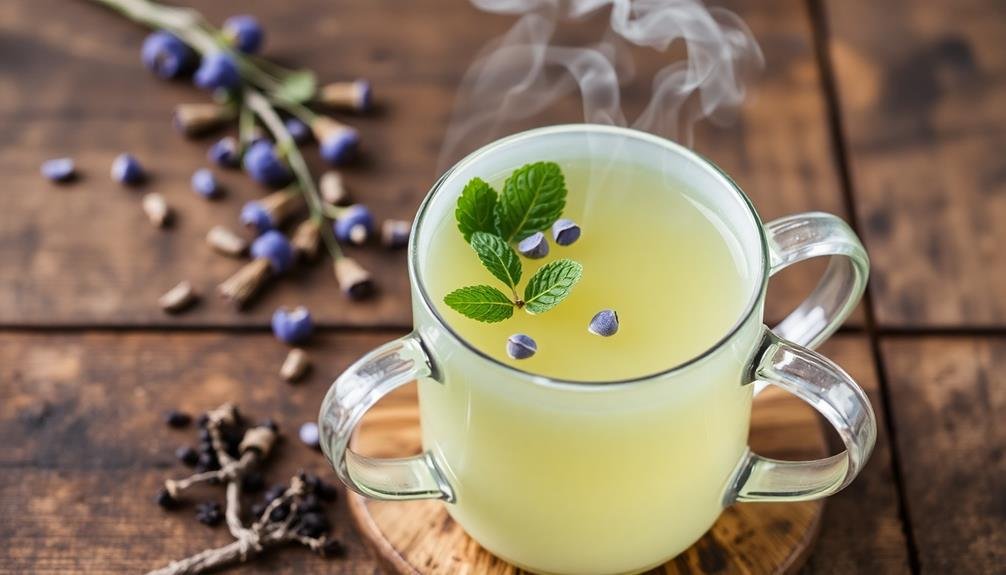
Peppermint and lavender team up to create a powerful herbal blend for headache relief. This combination targets different aspects of headache discomfort, making it an effective natural remedy.
Peppermint's menthol content helps relax tense muscles and improves blood flow, which can alleviate tension headaches. It also has a cooling effect that can soothe pain and reduce inflammation.
Lavender, on the other hand, is known for its calming properties. It can help reduce stress and anxiety, common triggers for headaches.
To prepare this blend, mix equal parts dried peppermint leaves and lavender buds. Steep a tablespoon of the mixture in hot water for 5-7 minutes. You can add honey for sweetness if desired.
Drink this tea at the onset of a headache or when you feel tension building. For an extra boost, try inhaling the steam from your cup as it steeps. The aromatherapy benefits of both herbs can provide quick relief.
You can also make a large batch of this blend and store it in an airtight container for future use. Remember to consult your healthcare provider if you experience frequent or severe headaches.
Chamomile and Lemon Balm Infusion
A soothing duo, chamomile and lemon balm combine to create a potent infusion for headache relief. These gentle herbs work synergistically to ease tension and promote relaxation, making them an excellent choice for stress-induced headaches.
Chamomile's anti-inflammatory properties help reduce pain, while lemon balm's calming effects ease anxiety and muscle tension. To prepare this infusion, steep 1 teaspoon each of dried chamomile flowers and lemon balm leaves in 8 ounces of hot water for 5-10 minutes.
Here's a quick guide to the benefits and preparation of this herbal blend:
| Herb | Benefits | Preparation |
|---|---|---|
| Chamomile | Reduces inflammation, promotes sleep | 1 tsp dried flowers |
| Lemon Balm | Calms nerves, eases muscle tension | 1 tsp dried leaves |
| Combined | Relieves headaches, promotes relaxation | Steep 5-10 minutes |
You can enhance the flavor and effectiveness of this infusion by adding a slice of fresh lemon or a teaspoon of honey. Drink this tea up to three times daily for maximum headache relief. Remember to consult your healthcare provider before using herbal remedies, especially if you're pregnant, nursing, or taking medications.
Ginger and Turmeric Tonic

You'll find a potent anti-inflammatory combination in this ginger and turmeric tonic.
The spicy blend offers natural pain relief, targeting headaches with its powerful compounds.
As an added benefit, you'll soothe your digestive system, which can often contribute to headache discomfort.
[DIRECTIONS]:
Anti-Inflammatory Powerhouse Blend
When seeking a powerful remedy for headaches, search no further than the Anti-Inflammatory Powerhouse Blend. This potent combination harnesses the anti-inflammatory properties of several herbs to target the root cause of many headaches.
Start with a base of green tea, known for its antioxidants and mild caffeine content that can help alleviate pain.
Add equal parts of dried ginger and turmeric to the mix. Ginger's natural compounds, like gingerols and shogaols, work to reduce inflammation and ease tension headaches. Turmeric, with its active ingredient curcumin, is a renowned anti-inflammatory agent that can help decrease headache intensity.
To enhance the blend's efficacy, include a pinch of black pepper. It contains piperine, which considerably increases the bioavailability of curcumin.
Round out the blend with chamomile and lavender, both known for their calming properties that can help relax tense muscles and promote overall relaxation.
Steep this blend in hot water for 5-7 minutes, allowing the herbs to release their beneficial compounds.
For best results, drink this tea at the first sign of a headache or regularly as a preventive measure.
Spicy Pain-Relieving Combination
Two powerhouse ingredients combine to create a spicy, pain-relieving tonic that's perfect for headache sufferers. Ginger and turmeric, both renowned for their anti-inflammatory properties, work together to tackle your headache from multiple angles.
Ginger's active compound, gingerol, helps reduce inflammation and pain, while turmeric's curcumin boosts your body's natural pain-fighting abilities. This dynamic duo not only eases your headache but also supports overall health.
To make this potent blend, you'll need:
| Ingredient | Amount | Benefits |
|---|---|---|
| Fresh ginger | 1 inch | Pain relief, anti-nausea |
| Turmeric powder | 1/2 tsp | Anti-inflammatory, antioxidant |
| Black pepper | Pinch | Enhances curcumin absorption |
Steep the ingredients in hot water for 5-10 minutes, strain, and sip slowly. You can add honey for sweetness if desired. This spicy tonic may cause a warming sensation as you drink it, signaling its active compounds at work.
For best results, drink this tea at the first sign of a headache. You'll likely notice relief within 30 minutes to an hour. Remember, consistency is key – regular consumption can help prevent future headaches.
Soothing Digestive Aid
The powerful combination of ginger and turmeric isn't just for headaches; it's also an excellent remedy for digestive issues. This tonic can help soothe your stomach, reduce bloating, and ease nausea.
Ginger's natural compounds, like gingerols and shogaols, have anti-inflammatory properties that can calm an upset stomach and improve digestion. Turmeric, with its active ingredient curcumin, supports digestive health by reducing inflammation in the gut and promoting the production of bile, which aids in fat digestion.
To prepare this soothing blend, steep fresh ginger slices and a pinch of turmeric powder in hot water for 5-10 minutes. You can add a squeeze of lemon and a touch of honey to enhance the flavor and boost its health benefits. Drink this tea before or after meals to support your digestive system.
If you're prone to indigestion or experience frequent stomach discomfort, consider making this ginger and turmeric tonic a regular part of your routine. It's a natural, caffeine-free alternative that can provide relief without the side effects often associated with over-the-counter medications.
Remember to consult your healthcare provider if you have persistent digestive issues or concerns.
Feverfew and Rosemary Mixture
A potent herbal duo, feverfew and rosemary combine to create a powerful headache-fighting blend. Feverfew, known for its ability to reduce inflammation and ease migraines, pairs perfectly with rosemary's circulation-boosting properties. This unique mixture not only targets headache pain but also promotes overall mental clarity and focus.
To prepare this soothing tea, steep one teaspoon each of dried feverfew leaves and rosemary in hot water for 5-10 minutes. Strain and sip slowly, allowing the herbs' beneficial compounds to work their magic. You'll likely notice a reduction in headache intensity within 30 minutes of consumption.
Here's why you should try this feverfew and rosemary blend:
- Feverfew contains parthenolide, which helps prevent blood vessel constriction
- Rosemary improves blood flow to the brain, reducing headache pressure
- The combination may offer faster relief than either herb alone
- Regular consumption may decrease the frequency of headaches
While this blend is generally safe for most people, it's crucial to consult your healthcare provider before using it, especially if you're pregnant, nursing, or taking medications.
Start with small amounts to gauge your body's response, and gradually increase the dosage if needed. Remember, consistency is key when using herbal remedies for headache relief.
Willow Bark and Meadowsweet Fusion
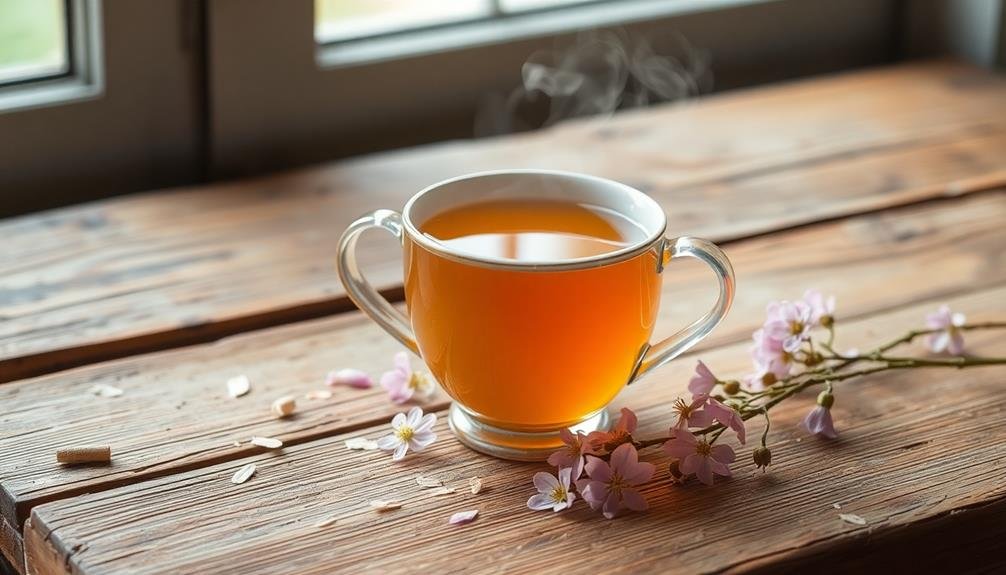
You'll find powerful natural pain relief in a fusion of willow bark and meadowsweet.
To prepare this blend, steep 1 teaspoon each of dried willow bark and meadowsweet in hot water for 10 minutes, then strain and drink up to 3 cups daily.
While generally safe, you should be aware of potential side effects like stomach upset or allergic reactions, especially if you're sensitive to aspirin.
Natural Pain-Relieving Properties
Harnessing nature's pain-relieving power, willow bark and meadowsweet combine to create a potent herbal tea blend for headache relief. These two herbs contain natural compounds that mimic the effects of aspirin, offering a gentler alternative to over-the-counter pain medications.
Willow bark's active ingredient, salicin, converts to salicylic acid in your body, reducing inflammation and easing discomfort. Meadowsweet complements this action with its own pain-relieving properties, while also soothing the stomach.
When you brew this herbal fusion, you'll benefit from:
- Reduced inflammation in blood vessels
- Decreased pain sensitivity
- Improved circulation to the head and neck
- A calming effect on the nervous system
To make the most of this natural remedy, steep one teaspoon each of dried willow bark and meadowsweet in hot water for 10-15 minutes. Strain and sip slowly, allowing the herbs' beneficial compounds to work their magic.
You can drink this tea up to three times daily for headache relief. Remember, while these herbs are generally safe, it's always wise to consult your healthcare provider before starting any new herbal regimen, especially if you're pregnant, nursing, or taking medications.
Preparation and Dosage
For ideal results, precise preparation and dosage of the willow bark and meadowsweet fusion are essential.
Begin by measuring 1 teaspoon of dried willow bark and 1 teaspoon of dried meadowsweet into a tea infuser or filter. Place the infuser in a mug and pour 8 ounces of hot water (just below boiling) over the herbs. Allow the tea to steep for 10-15 minutes, covering the mug to retain heat and beneficial oils.
After steeping, remove the infuser and add honey or lemon to taste if desired. Drink this tea blend up to three times daily, spacing doses at least 4 hours apart. It's best to start with one cup and observe how your body responds before increasing frequency.
Don't exceed the recommended dosage, as willow bark contains salicin, which can have side effects similar to aspirin when consumed in large amounts.
If you're pregnant, nursing, or taking blood thinners, consult your healthcare provider before using this blend.
For most headaches, you'll likely experience relief within 30-60 minutes of drinking the tea. If symptoms persist or worsen, seek medical attention.
Potential Side Effects
While the willow bark and meadowsweet fusion can offer relief from headaches, it's important to be aware of potential side effects. This herbal blend contains salicylates, which are similar to aspirin and can cause adverse reactions in some people. If you're allergic to aspirin or have a sensitive stomach, you should avoid this tea or consult your doctor before trying it.
Be cautious if you experience any of these symptoms after drinking the tea:
- Stomach upset or nausea
- Ringing in the ears
- Increased bleeding or bruising
- Skin rashes or hives
If you're pregnant, breastfeeding, or taking blood-thinning medications, it's best to avoid this herbal blend altogether. The salicylates in willow bark and meadowsweet can interfere with blood clotting and may cause complications.
Remember that natural doesn't always mean safe. While herbal teas can be beneficial, they can also interact with medications or exacerbate existing health conditions.
Always start with a small amount to test your tolerance, and stop using the tea if you experience any adverse effects. If symptoms persist or worsen, seek medical attention immediately.
Holy Basil and Passionflower Brew
Holy basil and passionflower combine to create a potent brew for headache relief. This herbal blend targets stress-induced headaches by calming your nervous system and reducing tension.
Holy basil, also known as Tulsi, is an adaptogenic herb that helps your body cope with stress and supports overall wellness. It contains eugenol, a compound known for its pain-relieving properties.
Passionflower complements holy basil by promoting relaxation and easing anxiety. It increases the production of GABA in your brain, a neurotransmitter that induces calmness and reduces tension headaches.
To prepare this brew, steep 1 teaspoon of dried holy basil and 1 teaspoon of dried passionflower in a cup of hot water for 5-7 minutes.
You can enhance the flavor and efficacy of this blend by adding a slice of lemon or a teaspoon of honey. Drink this tea up to three times daily for best results.
While generally safe, it's best to consult your healthcare provider before regular consumption, especially if you're pregnant, nursing, or taking medications.
This holy basil and passionflower brew offers a natural, soothing solution for headache relief without the side effects of over-the-counter pain medications.
Skullcap and Valerian Root Combo
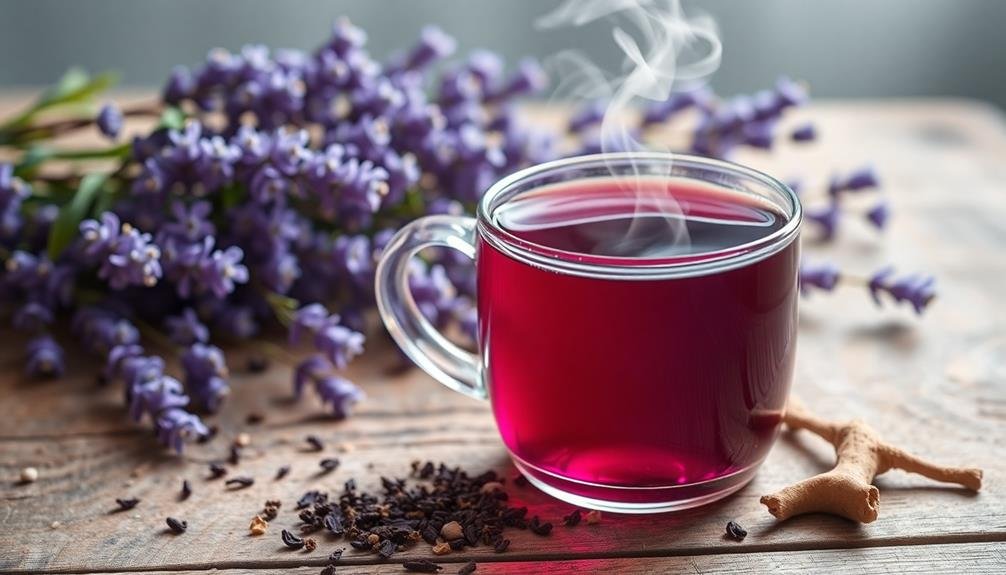
You'll find the Skullcap and Valerian Root combo particularly effective for headache relief due to its relaxing and pain-reducing properties.
To prepare, steep 1 teaspoon each of dried skullcap and valerian root in hot water for 10 minutes, then strain and drink up to 3 cups daily.
While generally safe, be aware that this blend may cause drowsiness, so it's best consumed in the evening or when you don't need to operate machinery.
Relaxation and Pain Relief
A powerful duo for combating headaches, skullcap and valerian root work together to promote relaxation and ease pain. These herbs have been used for centuries in traditional medicine to address various ailments, including tension headaches and migraines.
Skullcap acts as a mild sedative, helping to calm your nerves and reduce anxiety, while valerian root is known for its ability to improve sleep quality and relieve muscle tension.
When you brew a tea blend containing these two herbs, you're creating a natural remedy that can:
- Reduce stress and anxiety levels
- Ease muscle tension in your head and neck
- Promote better sleep, which can prevent headaches
- Provide mild pain relief without harsh side effects
To prepare this blend, steep 1 teaspoon each of dried skullcap and valerian root in hot water for 10-15 minutes. You can add a touch of honey or lemon for flavor.
It's best to drink this tea about an hour before bedtime, as it may cause drowsiness. Remember, while herbal remedies can be effective, it's always wise to consult with a healthcare professional before starting any new treatment regimen.
Dosage and Preparation Tips
While the combination of skullcap and valerian root can be effective for headache relief, proper dosage and preparation are key to maximizing their benefits.
For a single serving, use 1 teaspoon of dried skullcap and 1 teaspoon of dried valerian root. Steep this mixture in 8 ounces of boiling water for 10-15 minutes, then strain and drink.
You can prepare this blend up to three times daily, but don't exceed this amount as it may lead to drowsiness or other side effects. It's best to start with a lower dose and gradually increase it if needed.
Drink the tea about 30 minutes before you want to experience its effects.
To enhance the flavor and efficacy, you can add a slice of lemon or a teaspoon of honey. If you're using fresh herbs instead of dried, double the amount.
For convenience, you can make a larger batch and store it in the refrigerator for up to 48 hours.
Potential Side Effects
Although skullcap and valerian root are generally considered safe for most people, they can cause some side effects when used together. You might experience drowsiness, dizziness, or mild digestive discomfort. It's essential to start with a low dose and monitor your body's response.
If you're taking any medications, especially sedatives or blood thinners, consult your doctor before using this blend, as it may interact with these drugs.
Be aware of these potential side effects:
- Increased drowsiness, especially when combined with other sedatives
- Mild gastrointestinal upset, such as nausea or stomach cramps
- Headache or dizziness in some individuals
- Allergic reactions, though rare, can occur
If you're pregnant, breastfeeding, or have liver disease, avoid using this blend.
Don't drive or operate heavy machinery after consuming skullcap and valerian root tea, as it may impair your reflexes. If you experience any severe or persistent side effects, discontinue use and seek medical attention.
Linden Flower and Catnip Concoction
This soothing blend combines the calming properties of linden flower with the relaxing effects of catnip.
You'll find that linden flower, known for its mild sedative qualities, helps alleviate tension headaches by promoting relaxation and reducing stress. Catnip, on the other hand, contains nepetalactone, a compound that can ease pain and induce a sense of tranquility.
To prepare this concoction, steep 1 teaspoon of dried linden flowers and 1 teaspoon of dried catnip in a cup of hot water for 5-7 minutes. Strain and add honey if desired. For best results, drink this tea at the first sign of a headache or when you're feeling particularly tense.
While generally safe, it's essential to recognize that linden flower may interact with certain medications, particularly those for heart conditions.
Catnip is safe for most people but can cause drowsiness in high doses. If you're pregnant, breastfeeding, or have any underlying health conditions, consult your healthcare provider before incorporating this blend into your routine.
Butterbur and Boswellia Tea
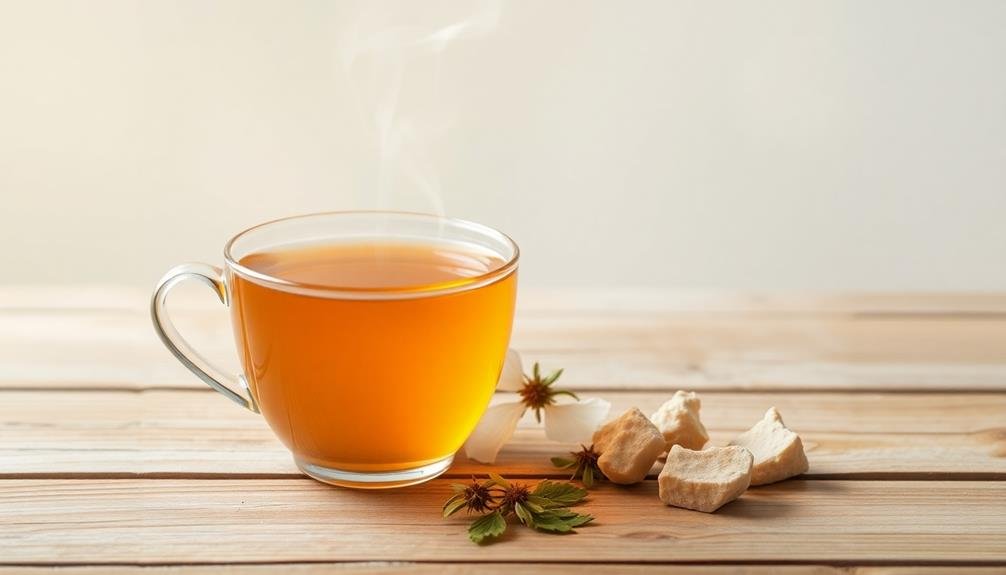
In light of their potent anti-inflammatory properties, butterbur and boswellia make an excellent tea blend for headache relief.
Butterbur, a shrub native to Europe and Asia, has been used for centuries to treat migraines and other types of headaches. Boswellia, also known as Indian frankincense, is a resin extract that's been shown to reduce inflammation and pain.
To prepare this powerful blend, steep 1 teaspoon of dried butterbur root and 1 teaspoon of boswellia resin in hot water for 10 minutes. Strain and enjoy the tea while it's warm. You can add a touch of honey or lemon for flavor if desired.
Here's why you should try this blend:
- Butterbur contains petasin, which helps relax blood vessels in the brain
- Boswellia inhibits pro-inflammatory enzymes, reducing pain and swelling
- The combination may provide faster relief than using either herb alone
- It's a natural alternative to over-the-counter pain medications
While this tea blend can be effective, it's important to consult with your healthcare provider before using it regularly, especially if you're pregnant, nursing, or taking other medications.
Some people may experience mild side effects like stomach upset or dizziness.
Green Tea and Eucalyptus Blend
Another powerful herbal tea blend for headache relief combines green tea and eucalyptus. This duo packs a punch against pain, with green tea's caffeine and L-theanine working to constrict blood vessels and reduce inflammation. Eucalyptus adds a cooling effect that can ease tension and promote relaxation.
To make this blend, steep 1 teaspoon of green tea leaves and 1/2 teaspoon of dried eucalyptus leaves in hot water for 5 minutes. Strain and enjoy while it's warm. You can add a touch of honey for sweetness if desired.
| Benefits | Green Tea | Eucalyptus |
|---|---|---|
| Pain Relief | ✓ | ✓ |
| Anti-inflammatory | ✓ | ✓ |
| Antioxidants | ✓ | ✓ |
| Stress Reduction | ✓ | ✓ |
| Respiratory Support | – | ✓ |
This blend is particularly effective for tension headaches and migraines. It's best to drink it at the first sign of a headache for maximum relief. Remember, while this tea can be helpful, it's not a substitute for medical advice. If you experience frequent or severe headaches, consult your healthcare provider for proper diagnosis and treatment.
Frequently Asked Questions
How Long Does It Take for Herbal Tea to Relieve a Headache?
You'll typically feel relief from herbal tea within 15-30 minutes. It depends on the type of tea and your body's response. For faster results, try steeping the tea longer or drinking it while it's still hot.
Can I Drink These Teas if I'm Pregnant or Breastfeeding?
You should be cautious when drinking herbal teas during pregnancy or breastfeeding. Some herbs can be harmful to your baby. It's best to consult your healthcare provider before consuming any herbal teas to guarantee they're safe.
Are There Any Side Effects Associated With Drinking Herbal Teas Regularly?
You might experience side effects from regular herbal tea consumption. These can include digestive issues, sleep disturbances, or interactions with medications. It's best to consult your doctor, especially if you have pre-existing health conditions or take regular medication.
How Many Cups of Herbal Tea Should I Drink for Headache Relief?
You should start with one cup of herbal tea for headache relief. If needed, you can drink up to 3-4 cups daily. Listen to your body and don't overdo it. Consult a doctor if symptoms persist.
Can I Combine These Herbal Teas With Over-The-Counter Pain Medications?
You can combine herbal teas with over-the-counter pain medications, but it's best to consult your doctor first. Some herbs may interact with medications, so it's important to be cautious and informed about potential side effects.
In Summary
You've now discovered a variety of herbal tea blends to combat your headaches naturally. Remember, these teas aren't just soothing; they're packed with potent compounds that can ease your discomfort. Don't hesitate to experiment with different combinations to find what works best for you. While these teas can offer relief, it's important to consult your healthcare provider if you're experiencing frequent or severe headaches. Embrace the power of nature and sip your way to comfort!

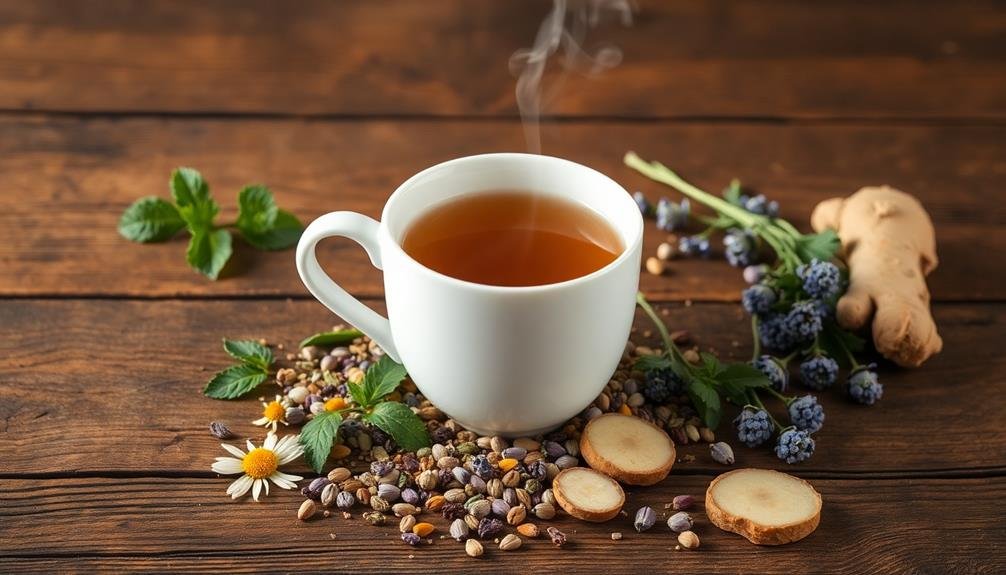
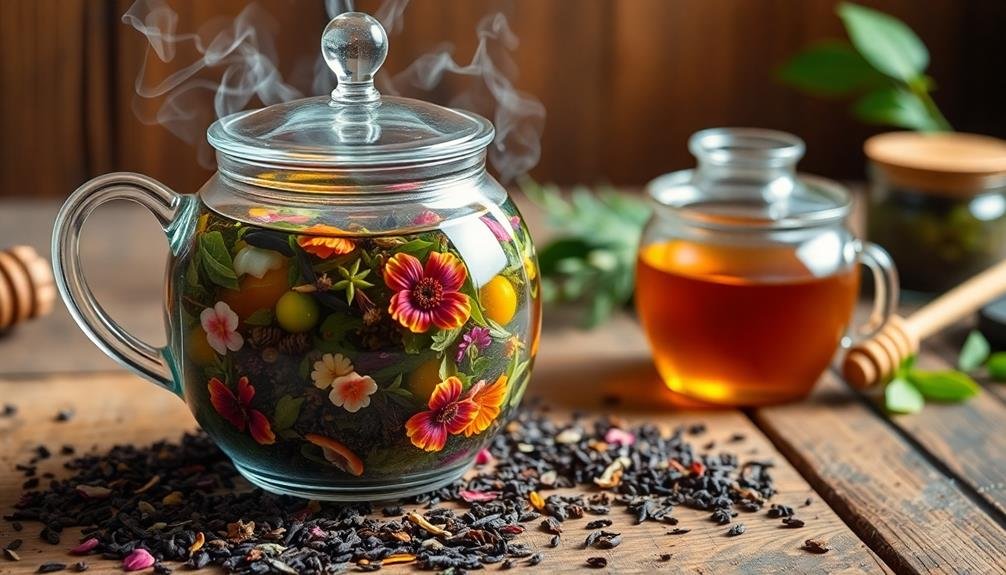
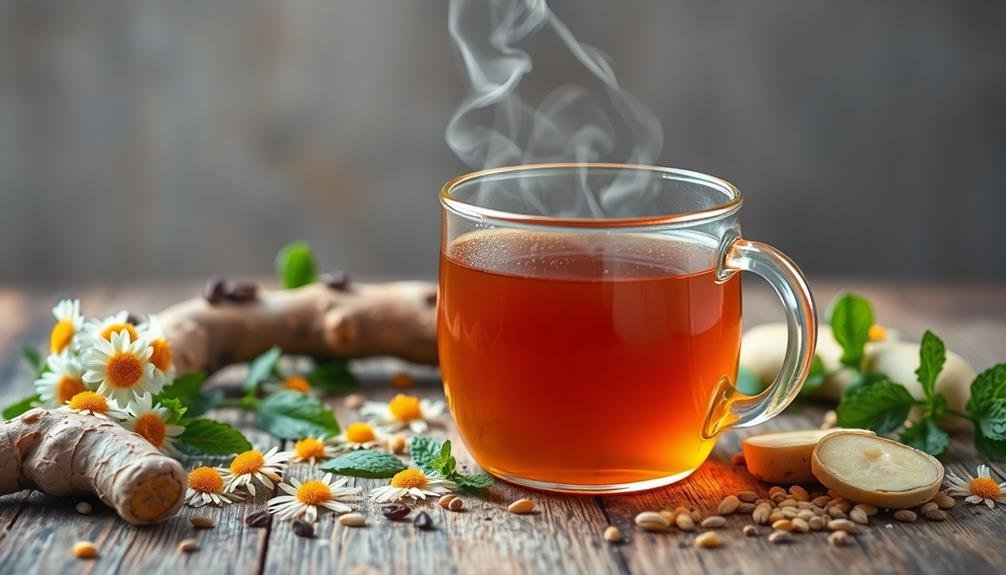
Leave a Reply